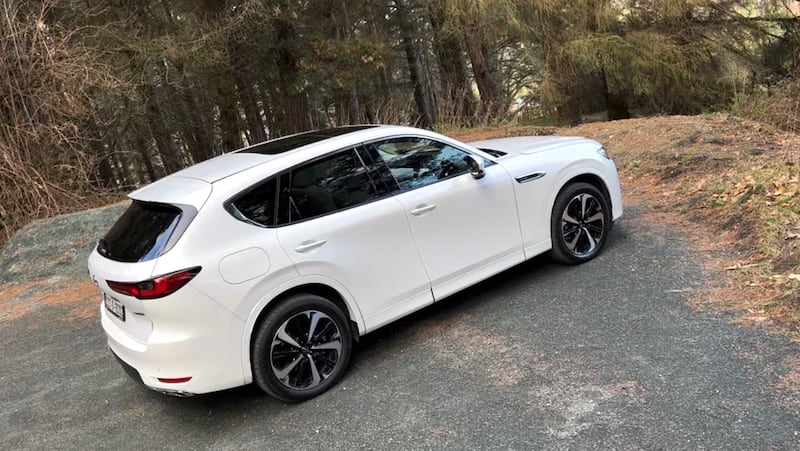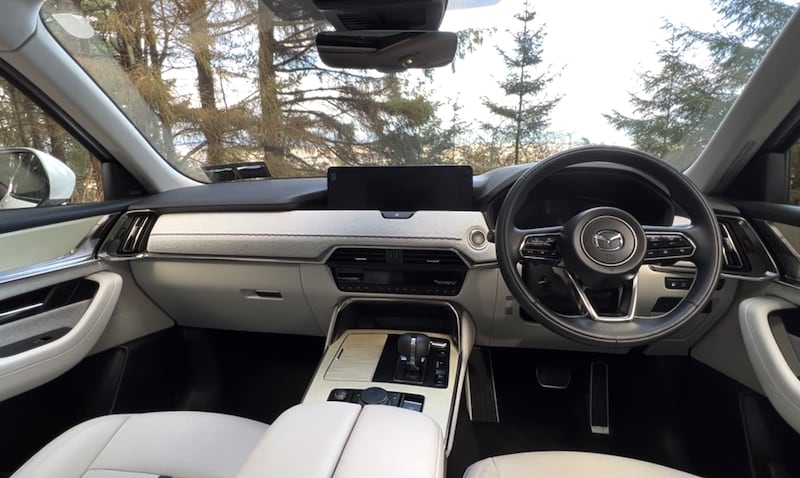I think it’s important to point out that what comes next gives me no joy. In this game, it can occasionally be fun to give an unpleasant or underperforming car a damn good literary thrashing, but when it’s a car made by Mazda, that becomes a burdensome task.
Why? Because it’s difficult in the extreme not to like and admire Mazda. One of the smallest Japanese car makers, it’s managed to produce some truly landmark cars down through the years, and its current roster of models is broadly impressive. Indeed, in the case of cars such as the Mazda 3 hatchback, the CX-30 Crossover, and the evergreen MX-5 sports car, it has some truly exceptional products in its portfolio.
The CX-60, however? Hang on while I try to find the keyboard shortcut for an onomatopoeic representation for the sound of air being sucked in between teeth in the manner of a plumber surveying your banjaxed boiler. “Fffsssttt” should cover it, I feel.
The CX-60 ought to be a bright new beginning for Mazda, being as it’s based on an all-new platform that replaces the old SkyActiv set-up in much-modified use since 2012. It’s a bigger, more overtly luxurious car than the current CX-5 SUV (again, a cracking family sized SUV) and it’s coming loaded with new tech, including Mazda’s first plug-in hybrid system.
100 Years of Solitude review: A woozy, feverish watch to be savoured in bite-sized portions
How your mini travel shampoo is costing your pocket and the planet - here’s an alternative
My smear test dilemma: How do I confess that this is my first one, at the age of 41?
The 50 best films of 2024 – the top 10 movies of the year

That plug-in hybrid uses a mixture of 2.5-litre petrol engine, a big electric motor, and a battery large enough to allow the XL-size CX-60 to boast a potential 64km range on electric power. Now, that all sounds quite similar to the system offered by Toyota and its conceptually similar RAV4 PHEV. Mazda and Toyota have a long-standing agreement to share technology and so it would seem logical that Mazda might have lightly tapped on Toyota’s front door to ask to borrow a cup of hybrid when it was developing the CX-60.
Logical, but wrong. The CX-60’s plug-in power-train is all Mazda’s own work, and the 2.5-litre engine is the same four-cylinder unit that you’ll find in the – sadly departed from this market – Mazda 6 saloon and estate. Equally sad as the 6 being gone is that this is not a very impressive PHEV system. Whereas the similar (and similarly priced) Toyota PHEV offers genuine 70km electric range and (we’ve tried and tested it) real-world 5.4-litres per 100km long-range fuel economy, the CX-60 struggles to get past 45km of real-world electric range, while its long-run economy plummets to 8.5-litres per 100km. We squeezed better than that out of a Range Rover PHEV recently.
Mazda also wants the CX-60 to be taken seriously as a rival to the likes of premium-brand models, such as the BMW X3, the Audi Q5, the Lexus NX, and the newly arrived Mercedes GLC. So, the CX-60 gets a cabin that aims to impress with luxury and refinement. To a point, this works. After all, Mazda’s build quality and reliability outstrips any of the aforementioned other than Lexus, and there’s no denying the solid construction of the CX-60’s insides.
However, it misses the mark in terms of fixtures and fittings. The touchscreen looks and works okay in CX-30 or CX-5, but up against the best that the premium boys have to offer, it seems a little lost. The new all-digital dials are nice, and the retaining of physical buttons for heating and ventilation (and seat heating and ventilation for this top-spec Takumi model too) is good, but details let it down. The pale wood trim and chunky fillet of chrome on each door looks more like the inside of a Las Vegas bathroom than a sleek German saloon.

Equally, space is not that impressive and neither are the front seats able to offer the sybaritic comfort of a BMW or Audi. Overall refinement is poor too. At motorway speeds, there’s a good deal of tyre roar (although wind noise is well suppressed) while at lower speeds… well, it’s all a bit odd. The engine part of the drivetrain is actually pretty decent – it has good poke and when you rev it hard it actually sounds quite good; sporty and raspy. The electric side, though, makes a series of very odd noises at slower urban speeds, wheezing and groaning in a very strange manner. It actually sounds similar to the sound effect used in Star Wars, when the golden-hued robot C-3PO moves his arms or legs – an irritating low-fi servo noise.
That’s not the worst aspect of the CX-60, though. The worst aspect is the ride quality. Now ride comfort, along with handling balance and steering sharpness, is a subjective area. One’s meat, another’s poison and so on, but I reckon the CX-60’s ride can be described as objectively bad. At high speeds, on motorways, it’s okay but mildly fidgety.
Around town – where you might think a PHEV ought to be driven most of the time, running on its battery – it’s downright awful. Over some bumps, it feels as if the shock absorbers have been filled in with concrete. Over others, it feels as if the suspension is flailing about, unattached to the body (an impression reinforced by the noisy clattering that ensues). Over yet more bumps it’s oddly serene and calm, indicating there might be some talent in there, but boy is it latent.
The CX-60 feels, ultimately, like a car set up for US tastes and mores, and not for European ones, which really just about scuppers any chance it had of competing with those premium European models. There’s a faint irony that the less overtly luxurious CX-5, a car whose bones date back to 2012, remains a vastly nicer car to drive.
Perhaps Mazda can improve the CX-60. There is a 3.3-litre straight-six mild-hybrid diesel version out there (yes, you read that correctly) which may improve on the PHEV’s dynamic manners, and maybe we can chalk this one up to being the first try with a new platform. That this is still the Mazda of the 3, the CX-30, and the MX-5 would allow us to at least place some hope in that tiny fiction.
Lowdown: Mazda CX-30 PHEV Takumi
Power: 2.5-litre four-cylinder petrol engine plus 100kW electric motor developing 328hp and 500Nm, powering the all-four wheels via an eight-speed automatic transmission.
CO2 emissions (annual motor tax): 33g/km (€140).
Fuel consumption: 1.5l/100km (WLTP).
0-100km/h: 5.8sec.
Price: €65,490 as tested, CX-60 starts from €54,100.
Our rating: 1/5.
Verdict: Dreadful ride and so-so PHEV performance leave the CX-60 lost at sea.





